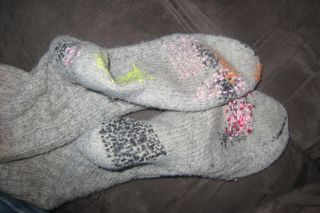You donít really need a large wardrobe of fancy Gore-tex jackets, trousers and boots to enjoy the outdoors.
When I was a kid we mostly used high rubber boots (wellies), jeans and cotton anoraks, or old army jackets.
Of course we had the traditional knitted woolen socks, sweaters, long johns and knitted caps as well, but special hiking or outdoor clothes were rare.
When it rained we were wet, in winter we was often cold, but we was mostly outdoors, unlike todayís kids with all their gore-tex clothes.
That said I highly recommend gore-tex clothing. It is perfect for our rainy environment, but you donít need it. A good raingear or a poncho will also do.
When Iím out in summer I mostly use a T-shirt/cotton shirt, a cotton boxer underneath a cotton/polyester mix trousers and a surplus german flecktarn gore-tex jacket (matching the trousers mentioned below).
While I use a variety of different trousers I often use the Fjellreven Iceland trousers in G1000 fabric (below right).
The trousers are light, dries fast when wet and look to be very though. It is supposed to be waterproofed with beeswax/paraffin wax but I havenít bothered to do it after I washed them last time.
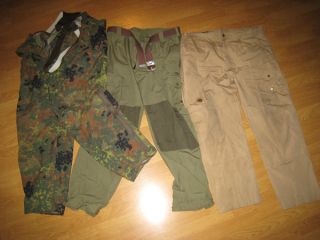
The trousers are very good but I donít see why these trousers should cost 1000 NOK as they are not so much better than most of my other trousers which costed me 250 NOK. I have the feeling that I paid a lot for the sleeping leather fox the trousers are marked with.
Earlier I used army surplus woollen trousers in the colder seasons, and I loved them. They were cheap, warm and rugged. Sadly I have outgrown them and they are very hard to come by these days, at least in my size.
I bought some new ones in January 2010 (Jahtijakt) and will try these. What I think of them will be said here later (I actually bought both trousers and jacket).
The Jahtijakt set was not very good. The fabric was too thin and teared easily. In 2012 I bought another wool jacket wich was far better.
I have some German fleck tarn gore-tex trousers (left on the trousers picture) which I got very cheap. These are light and watertight and have found their way into my rucksack for really wet weather use (spring and autumn) and also as a wind breaker in winter.
I just wear them outside my other trousers. The trousers are fitted with suspenders and long zips on the sides to take them on while wearing your boots.
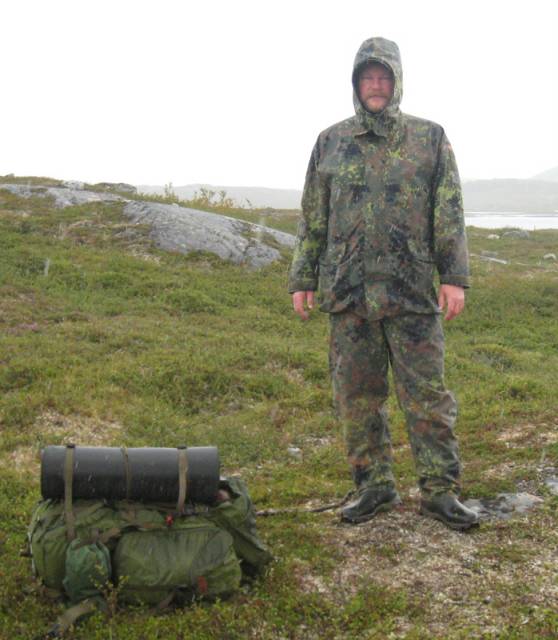
The german flecktarn gore tex jacket suits my need very well (Replacement for my old Bergans Dermizax jacket). It is light, windproof and waterproof. When not needed it is rolled together and stashed away in my rucksack.
I like the jacket to have a fixed hood. I feel it isnít a real jacket if it hasnít got a fixed hood. I want that extra protection a hood gives against the wind, rain and snow.
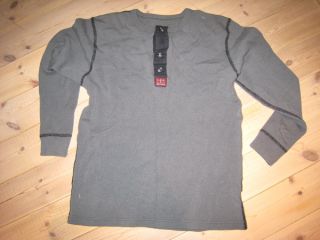
The T-shirt is occasionally swapped for a woolen undershirt (photo above). On my feet I mostly wear thick woolen socks only.
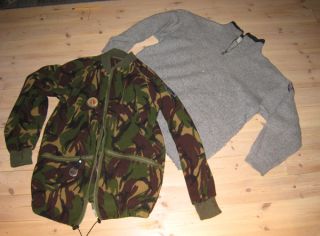
I also have with me a woolen sweater or a fleece jacket in my bag as a mid layer (picture above). These are stowed away in my rucksack and taken out if needed. I donít use the mid layer when walking longer walks. The woolen undershirt is sufficient, even in winter.
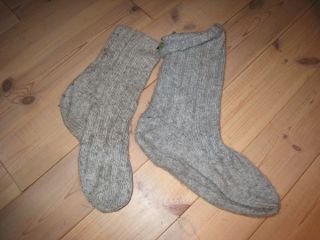
Spare socks (wool) and extra underwear is always nice.
On my head I have (mostly) a cotton hat or a baseball style cap like those on the picture below. The first is an ordinary baseball cap. The blue one is made of wool with a layer of thinsulate. It is nice in spring or fall.
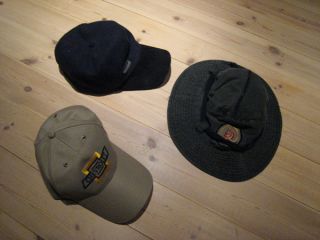
The hat has an integrated mosquito net (the zip at the top and picture above right). Not that I use the mozzie net a lot, but it is nice to have when one is working and the mosquitoes are very disturbing.
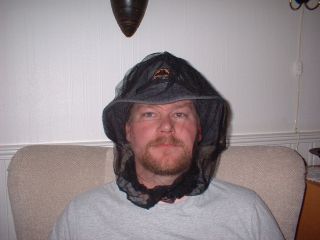
I have waterproofed the hat with a beeswax/paraffin wax mix (1 part beeswax and 9 parts paraffin wax). The mix is rubbed in and melted into the fibers with a hair dryer. This works very good.
On my feet I wear Spotec sandals if the weather is warm and a pair of neoprene boots (Grub`s extreme) if it isnít so nice weather (both on pictures below).
The Spotec sandal is a tough hardwearing sandal which sits well on the foot. The sandal was in use with the Norwegian UN force in Lebanon Iím told. I have used these sandals for 7-8 years now and they are still holding together (the rubber sole is a little harder than when they wher new though).
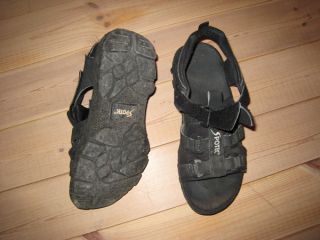
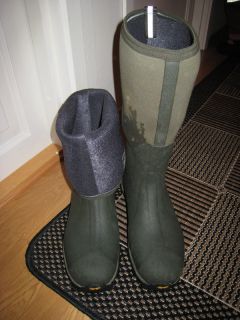
The Grub`s boots (Grubs extreme long) are my 3 seasons (spring, summer and fall) wear. They are lightweight and rugged. The boots cannot be compared to the old rubber wellies of my childhood.
You will sweat in the Grub`s boots too, but no way near the old wellies and besides it is no problem taking them off in the end of the day.
The old rubber boots kind of sucked itself to the foot, making them almost impossible to take off without ripping some muscles.
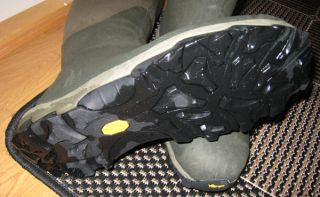
The Grub`s boots have a thick vibram sole (above) which offers good traction. The support of the ankle is no way near that offered by a leather boot, but I donít have a problem with it. Besides Iíve seen people sprain their ankles in the sturdiest of leather boots.
In winter almost all the cotton clothes are replaced with wool and woolen long johns, and headover (long tubular woolen scarf, like the Buff, picture below) are added.
The headover could also be used as a hat.
The headwear I mostly use is a knitted cap (army issue, picture below right) unless it is very cold or bad weather.
One cotton item I still in use in winter though, and that is the anorak. I have a Fjellreven Gutulia in G1000 fabric (I`m wearing it in the picture above). The anorak is lightweight and does "breathe" in the cold unlike various tex membrane clothing.
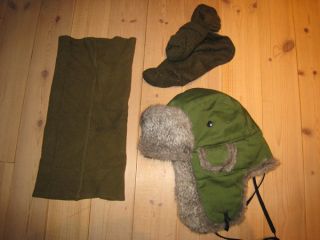
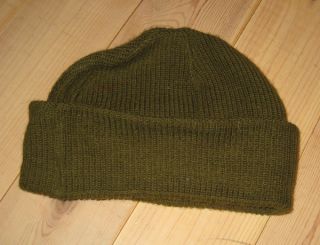
When I travel higher up in the mountain or on longer trips I bring along my old fur hat as well (picture above).
It is made of (cotton/polyester) and has a lining of rabbit fur. It was cheap. Iíve seen hats selling for about 3 or 4 times this. But still the quality is very good.
I also have one in fleece branded Shimano which I occasionally use. This type of hat is called a Korean hat I think. It is however not as wind proof as the cotton/polyester hat.
I wear woolen mittens with polyester/cotton outer layer on my hands (army issue, picture below).I use mittens because they are superior to gloves in cold weather. Nothing scares me as seeing survival experts running trough Siberia in -30 -40 degrees below zero wearing thin gloves.
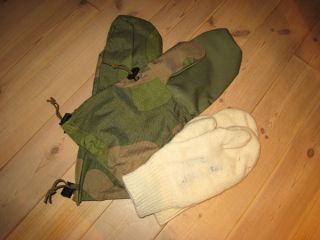
The mittens are attached to each other with a length of paracord, and a loop is made with yet another piece of paracord. The loop goes over the head securing the mittens against blowing away if I take them off in high wind.
In wintertime, if the snow depth permits it, I wear my Old Norwegian army boots (picture below).
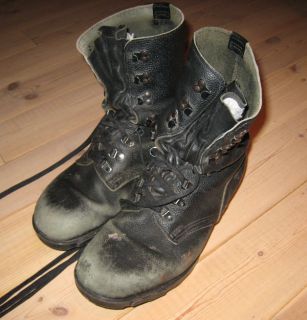
They are cheap (I get them for free from the government :)) and rugged. They require daily maintenance though. A good coating with kiwi shoe polish is usually enough.
You will see that the daily maintenance on my boots are somewhat lacking. But do as I say not as I do.
I also have a pair of over boots for the army boots if it is really cold or wet winter conditions, but I seldom use them. Sometimes they are used as camp shoes when icefishing in the mountains.
If it is very cold I often use a pair of felt shoes with plastic sole called "Nesnalobben"(picture below). These shoes are very light and warm and I highly recommend them. But if the snow is wet they are almost useless as they soak up moisture.
I often take these along when Iím skiing in the mountains, to replace my ski boots (below right) when making camp.
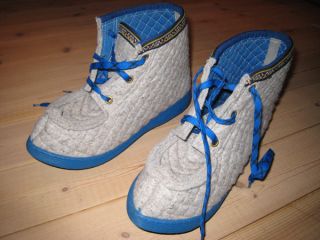
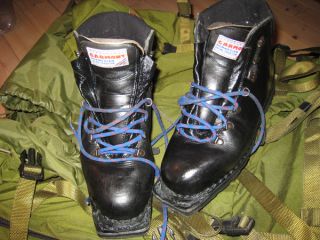
Together with the ski boots (and felt shoes) I use knee length cotton gaiters. That way the boots will not be filled with snow.
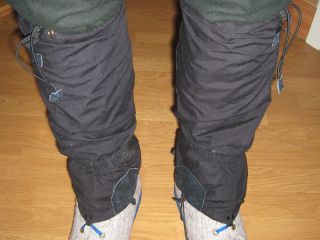
The reason I use cotton gaiters is that they ďbreatheĒ well. I had some earlier, made of water proof nylon and they made my trousers wet inside the gaiters.
Some people also use gaiters in summer to prevent dirt and debris from entering their shoes. Normally those using low walking boots.
The Saamis use reindeer hide boots (fur out) called "skaller" in winter. They are very good and if you can get hold of a pair you should buy them. They will be nice on long cold winter evenings or when ice fishing. These are also used only in dry conditions. I don`t own any myself as they are quite expensive.
These boots were traditionally used with grass (ďSennegressĒ Carex vesicaria or ďFlaskestarrĒ Carex rostrata) stuffing instead of socks. Some saamis still do, but most people use a felted inner shoe.
Repairing your clothes.

I usually carry some sewing needles, tread, buttons and safety pins with me.
I don`t use it very often, but occasionally a button fall of my shirt or a seam is broken.
I think it is nice to have some tools to mend these before they get bigger and ruin the whole garment.
The equipment don`t weigh much either.
I usually carry the small set we were equipped with in the army (above). They are neat and donít take up much room. Still it contains most of the things you need.
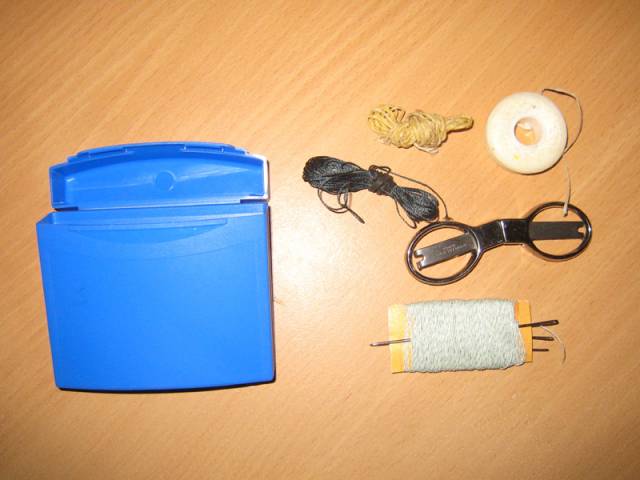
You could also make your one set using a suitable container (above).
Just make sure it has what you need and that the size is so small that you actually bother taking it with you.
Below is a pair of wool socks which got a little longer use with mending.
